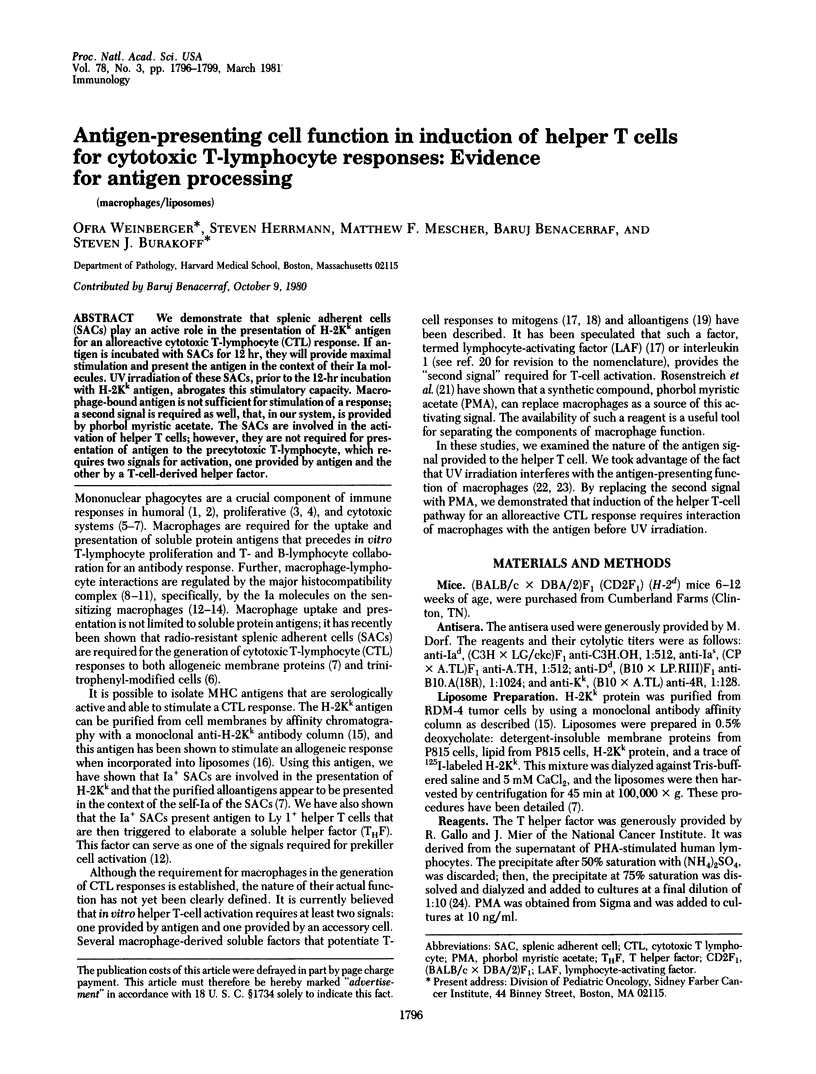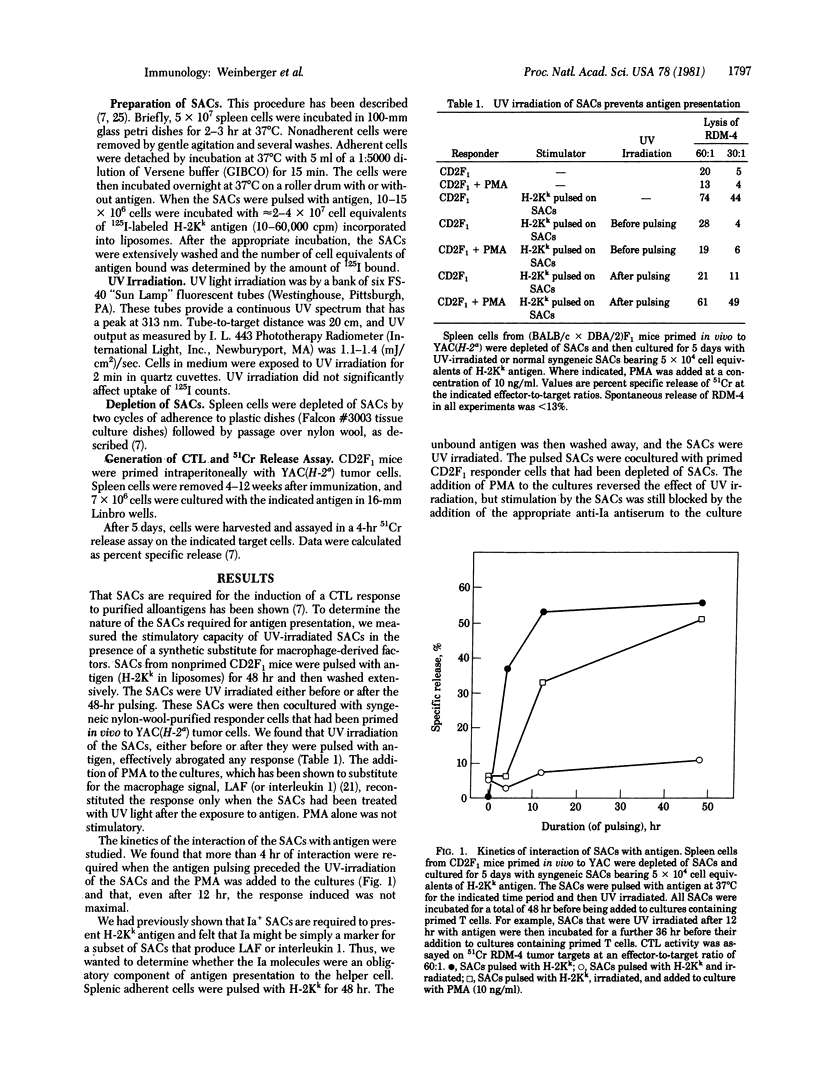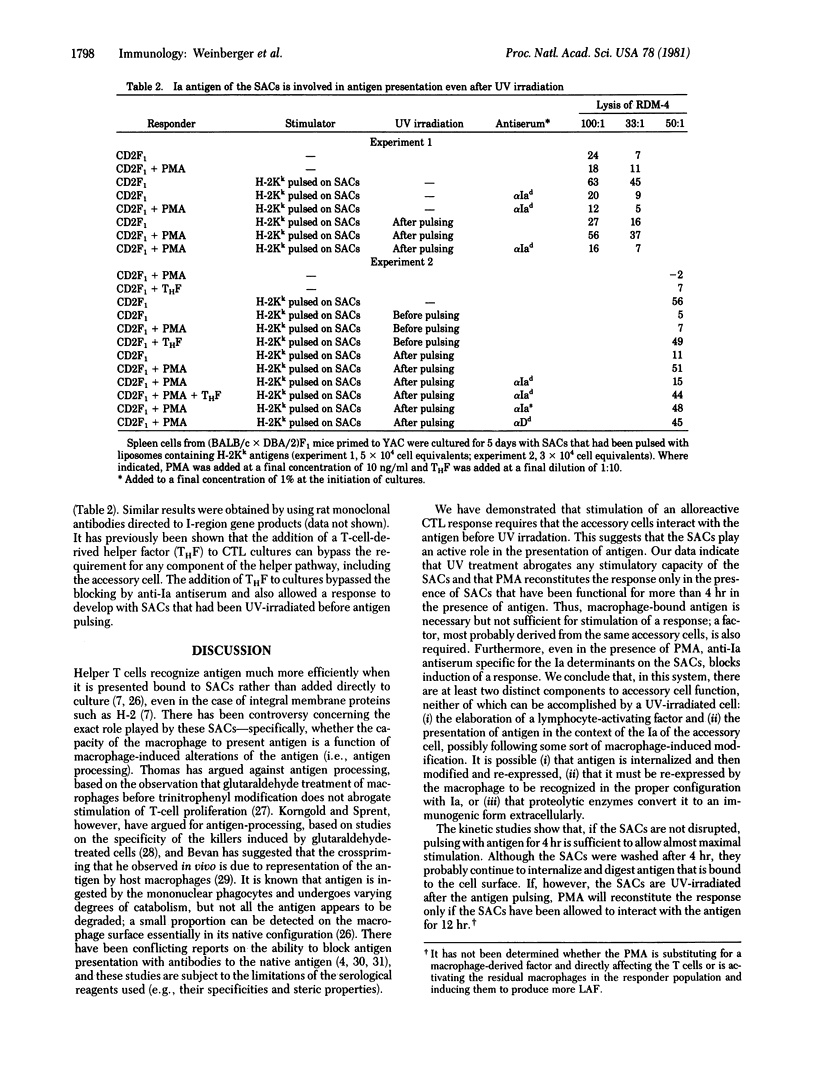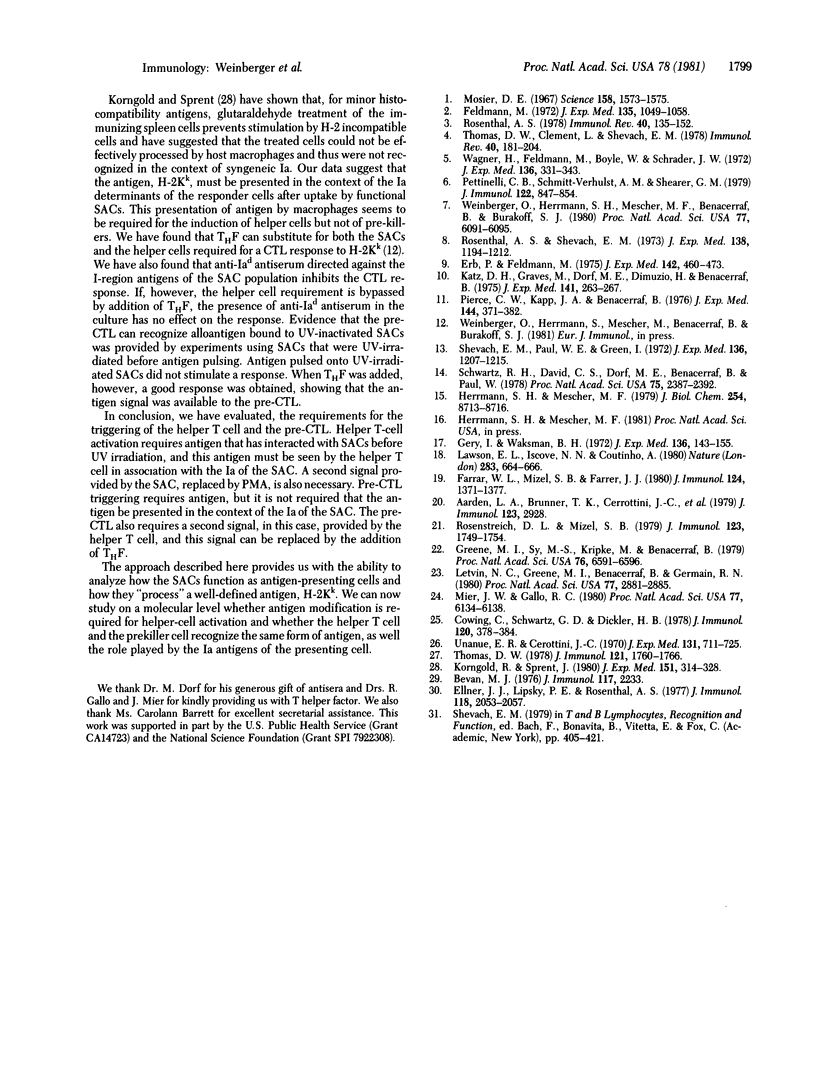Abstract
We demonstrate that splenic adherent cells (SACs) play an active role in the presentation of H-2Kk antigen for an alloreactive cytotoxic T-lymphocyte (CTL) response. If antigen is incubated with SACs for 12 hr, they will provide maximal stimulation and present the antigen in the context of their Ia molecules. UV irradiation of these SACs, prior to the 12-hr incubation with H-2Kk antigen, abrogates this stimulatory capacity. Macrophage-bound antigen is not sufficient for stimulation of a response; a second signal is required as well, that, in our system, is provided by phorbol myristic acetate. The SACs are involved in the activation of helper T cells; however, they are not required for presentation of antigen to the precytotoxic T-lymphocyte, which requires two signals for activation, one provided by antigen and the other by a T-cell-derived helper factor.
Full text
PDF



Selected References
These references are in PubMed. This may not be the complete list of references from this article.
- Bevan M. J. Minor H antigens introduced on H-2 different stimulating cells cross-react at the cytotoxic T cell level during in vivo priming. J Immunol. 1976 Dec;117(6):2233–2238. [PubMed] [Google Scholar]
- Cowing C., Schwartz B. D., Dickler H. B. Macrophage Ia antigens. I. macrophage populations differ in their expression of Ia antigens. J Immunol. 1978 Feb;120(2):378–384. [PubMed] [Google Scholar]
- Ellner J. J., Lipsky P. E., Rosenthal A. S. Antigen handling by guinea pig macrophages: further evidence for the sequestration of antigen relevant for activation of primed T lymphocytes. J Immunol. 1977 Jun;118(6):2053–2057. [PubMed] [Google Scholar]
- Erb P., Feldmann M. The role of macrophages in the generation of T-helper cells. II. The genetic control of the macrophage-T-cell interaction for helper cell induction with soluble antigens. J Exp Med. 1975 Aug 1;142(2):460–472. doi: 10.1084/jem.142.2.460. [DOI] [PMC free article] [PubMed] [Google Scholar]
- Farrar W. L., Mizel S. B., Farrar J. J. Participation of lymphocyte activating factor (Interleukin 1) in the induction of cytotoxic T cell responses. J Immunol. 1980 Mar;124(3):1371–1377. [PubMed] [Google Scholar]
- Feldmann M. Cell interactions in the immune response in vitro. II. The requirement for macrophages in lymphoid cell collaboration. J Exp Med. 1972 May 1;135(5):1049–1058. doi: 10.1084/jem.135.5.1049. [DOI] [PMC free article] [PubMed] [Google Scholar]
- Gery I., Waksman B. H. Potentiation of the T-lymphocyte response to mitogens. II. The cellular source of potentiating mediator(s). J Exp Med. 1972 Jul 1;136(1):143–155. doi: 10.1084/jem.136.1.143. [DOI] [PMC free article] [PubMed] [Google Scholar]
- Greene M. I., Sy M. S., Kripke M., Benacerraf B. Impairment of antigen-presenting cell function by ultraviolet radiation. Proc Natl Acad Sci U S A. 1979 Dec;76(12):6591–6595. doi: 10.1073/pnas.76.12.6591. [DOI] [PMC free article] [PubMed] [Google Scholar]
- Herrmann S. H., Mescher M. F. Purification of the H-2Kk molecule of the murine major histocompatibility complex. J Biol Chem. 1979 Sep 25;254(18):8713–8716. [PubMed] [Google Scholar]
- Katz D. H., Graves M., Dorf M. E., Dimuzio H., Benacerraf B. Cell interactions between histoincompatible T and B lymphocytes. VII. Cooperative responses between lymphocytes are controlled by genes in the I region of the H-2 complex. J Exp Med. 1975 Jan 1;141(1):263–268. doi: 10.1084/jem.141.1.263. [DOI] [PMC free article] [PubMed] [Google Scholar]
- Korngold R., Sprent J. Selection of cytotoxic T-cell precursors specific for minor histocompatibility determinants. I. Negative selection across H-2 barriers induced with disrupted cells but not with glutaraldehyde-treated cells: evidence for antigen processing. J Exp Med. 1980 Feb 1;151(2):314–327. doi: 10.1084/jem.151.2.314. [DOI] [PMC free article] [PubMed] [Google Scholar]
- Larsson E. L., Iscove N. N., Coutinho A. Two distinct factors are required for induction of T-cell growth. Nature. 1980 Feb 14;283(5748):664–666. doi: 10.1038/283664a0. [DOI] [PubMed] [Google Scholar]
- Letvin N. L., Greene M. I., Benacerraf B., Germain R. N. Immunologic effects of whole-body ultraviolet irradiation: selective defect in splenic adherent cell function in vitro. Proc Natl Acad Sci U S A. 1980 May;77(5):2881–2885. doi: 10.1073/pnas.77.5.2881. [DOI] [PMC free article] [PubMed] [Google Scholar]
- Mier J. W., Gallo R. C. Purification and some characteristics of human T-cell growth factor from phytohemagglutinin-stimulated lymphocyte-conditioned media. Proc Natl Acad Sci U S A. 1980 Oct;77(10):6134–6138. doi: 10.1073/pnas.77.10.6134. [DOI] [PMC free article] [PubMed] [Google Scholar]
- Mosier D. E. A requirement for two cell types for antibody formation in vitro. Science. 1967 Dec 22;158(3808):1573–1575. doi: 10.1126/science.158.3808.1573. [DOI] [PubMed] [Google Scholar]
- Pettinelli C. B., Schmitt-Verhulst A. M., Shearer G. M. Cell types required for H-2-restricted cytotoxic responses generated by trinitrobenzene sulfonate-modified syngeneic cells or trinitrophenyl-conjugated proteins. J Immunol. 1979 Mar;122(3):847–854. [PubMed] [Google Scholar]
- Pierce C. W., Kapp J. A., Benacerraf B. Regulation by the H-2 gene complex of macrophage-lymphoid cell interactions in secondary antibody responses in vitro. J Exp Med. 1976 Aug 1;144(2):371–381. doi: 10.1084/jem.144.2.371. [DOI] [PMC free article] [PubMed] [Google Scholar]
- Rosenstreich D. L., Mizel S. B. Signal requirements for T lymphocyte activation. I. Replacement of macrophage function with phorbol myristic acetate. J Immunol. 1979 Oct;123(4):1749–1754. [PubMed] [Google Scholar]
- Rosenthal A. S., Shevach E. M. Function of macrophages in antigen recognition by guinea pig T lymphocytes. I. Requirement for histocompatible macrophages and lymphocytes. J Exp Med. 1973 Nov 1;138(5):1194–1212. doi: 10.1084/jem.138.5.1194. [DOI] [PMC free article] [PubMed] [Google Scholar]
- Schwartz R. H., David C. S., Dorf M. E., Benacerraf B., Paul W. E. Inhibition of dual Ir gene-controlled T-lymphocyte proliferative response to poly (Glu56Lys35Phe9)n with anti-Ia antisera directed against products of either I-A or I-C subregion. Proc Natl Acad Sci U S A. 1978 May;75(5):2387–2391. doi: 10.1073/pnas.75.5.2387. [DOI] [PMC free article] [PubMed] [Google Scholar]
- Shevach E. M., Paul W. E., Green I. Histocompatibility-linked immune response gene function in guinea pigs. Specific inhibition of antigen-induced lymphocyte proliferation by alloantisera. J Exp Med. 1972 Nov 1;136(5):1207–1221. doi: 10.1084/jem.136.5.1207. [DOI] [PMC free article] [PubMed] [Google Scholar]
- Thomas D. W., Clement L., Shevach E. M. T lymphocyte stimulation by hapten-conjugated macrophages: a model system for the study of immunocompetent cell interactions. Immunol Rev. 1978;40:181–204. doi: 10.1111/j.1600-065x.1978.tb00406.x. [DOI] [PubMed] [Google Scholar]
- Thomas D. W. Hapten-specific T lymphocyte activation by glutaraldehyde-treated macrophages: an argument against antigen processing by macrophages. J Immunol. 1978 Nov;121(5):1760–1766. [PubMed] [Google Scholar]
- Unanue E. R., Cerottini J. C. The immunogenicity of antigen bound to the plasma membrane of macrophages. J Exp Med. 1970 Apr 1;131(4):711–725. doi: 10.1084/jem.131.4.711. [DOI] [PMC free article] [PubMed] [Google Scholar]
- Wagner H., Feldmann M., Boyle W., Schrader J. W. Cell-mediated immune response in vitro. 3. The requirement for macrophages in cytotoxic reactions against cell-bound and subcellular alloantigens. J Exp Med. 1972 Aug 1;136(2):331–343. doi: 10.1084/jem.136.2.331. [DOI] [PMC free article] [PubMed] [Google Scholar]
- Weinberger O., Herrmann S. H., Mescher M. F., Benacerraf B., Burakoff S. J. Cellular interactions in the generation of cytolytic T lymphocyte responses: role of Ia-positive splenic adherent cells in presentation in H-2 antigen. Proc Natl Acad Sci U S A. 1980 Oct;77(10):6091–6095. doi: 10.1073/pnas.77.10.6091. [DOI] [PMC free article] [PubMed] [Google Scholar]


